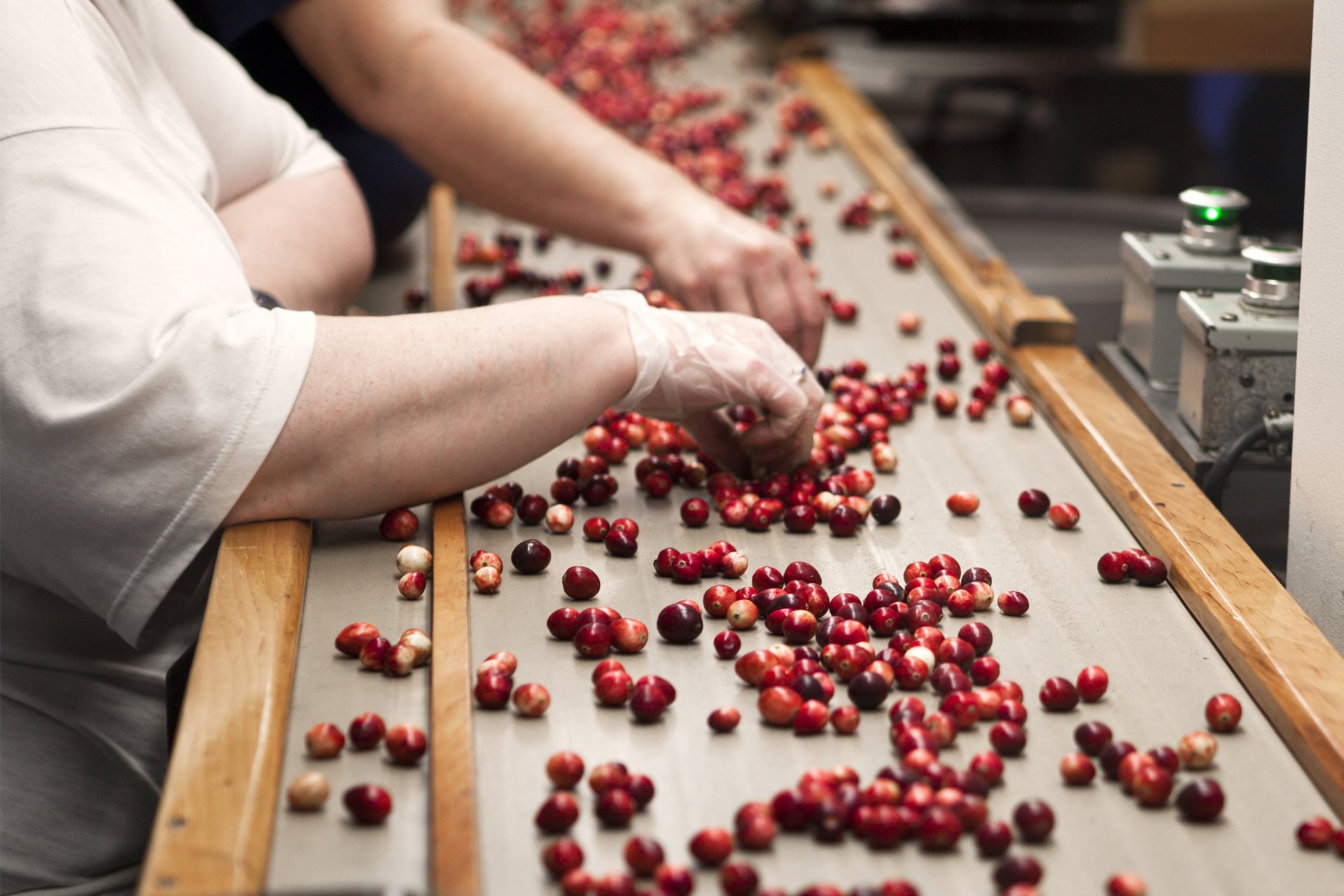As the world’s population grows, so does the demand for food and drink. But that’s not all. Consumers want more than just food and drink for sustenance; their demands are now more health, ethically and environmentally-driven. And so enters the rise in popularity of plant-based, allergen/intolerance-friendly, organic and locally sourced or fair-trade food and drink that use less or sustainable packaging.
That’s just consumer demands - a small portion of the current issues in the food and beverage industry.
There are also regulatory standards to meet, allergens to minimise (or ensure their highlighted accurately), waste to manage, margins to increase and the need to be prepared for any unforeseeable circumstances.
It’s no wonder the food and beverage industry is under immense pressure. Juggling all those plates while still ensuring your product quality is high and you’re thinking of new ways to innovate isn’t easy. But failure to do so can lead to some damaging repercussions.
The best way to overcome these challenges is to transform your business. Digitalise with tools/software (such as an ERP solution) and you’ll find it’s much easier to withstand market pressures. But it’s more than just ‘digitally transforming’ – you need the right digital strategy in place and buy-in across your business (from both senior management and the everyday users) if you want to succeed.
This is what this resource will be covering. From some of the biggest challenges faced by the industry and how to solve them to why digital transformation isn’t just a buzzword, we will look at how you can ensure success from it, there’s a lot to know. So, let’s get started.
TIP: Just a heads up – there’s going to be a lot of content. To make it easier for you, we’ve added ‘back to top’ links throughout this resource at regular intervals so you can go straight back up at any point. We also recommend you bookmark this resource or save it to your desktop so you can leave and come back to it whenever.
Chapters
1. What are the most common issues facing the food and beverage industry and how can they be tackled?
2. The impact of technology in the food industry
4. What's next?
1. What are the most common issues facing the food and beverage industry and how can they be tackled?
Meeting regulations and standards
As the number of laws, regulations and guidelines that govern the sector increase, the trickier it is for food and drink businesses to keep an eye on all of these and keep up with their production demands. Plus, when new regulations are introduced, they often require quick action – yet not all of them are entirely clear which makes rapid responses even more difficult.
For example, the introduction of Natasha’s Law aims to protect consumers with allergies and give them more confidence in the food and drink they buy. For businesses, it calls for more effective traceability and allergen management processes and requires them to include a more comprehensive list of allergens along with their products.
How can this challenge be tackled?
An effective traceability process and tracking tools, such as serialised box tracking, can help ensure food safety.
These tools allow you to closely monitor your food production from field to fork so you can take a proactive approach to risk management. If risks are identified, it’s much easier to trace all stages of production, including the long chain of suppliers and retailers. It also makes it easier for product recall to be actioned quickly and at a local scale rather than national.
Tackling allergen management
Leading on from the above challenge, it’s important for food and drink businesses to efficiently tackle allergen management. According to global law firm RPC, allergen-related food recalls increased by 20% in 2019 (the highest ever in the last five years).
There are also concerns surrounding the dangers of poorly labelled foods. This, combined with the further regulatory changes like Natasha’s Law and the need to decrease liability, just shows how vital it is for food and beverage businesses to manage and minimise the risks of allergens.

How can this challenge be tackled?
There are some allergen-inducing foods that are commonly used in recipes for particular food and drink products so it’s not always easy for consumers to simply stay away from them. Instead, consumers are relying on manufacturers and distributors to have tighter controls over the use of allergens and to disclose this information accurately and in a timely manner with the public.
To efficiently manage and control allergens, you need to be able to add the appropriate allergen data to any item and track this through the supply chain. The right technology can help. For example, an ERP solution can centralise this information so it becomes much easier for you to manage your allergen information in one place.
We’ll be discussing this in more detail in a later section. Keep reading and learning or go right to the section by clicking here.
Managing product recalls
Product recalls are, unfortunately, not a rare occurrence. There have been many reports of products being recalled due to a variety of reasons, such as allergens not being mentioned on the label, packaging errors and even because they may contain small pieces of plastic and metal.
Recalls are not without negative consequences. When the safety of a food or drink product is called into question, it can lead to bad publicity, loss of customer loyalty, damaged brand image and more. And this is assuming the product is recalled before a customer consumes it.
How can this challenge be tackled?
Judging from the reasons for product recalls, it suggests there’s often a breakdown in the processes facilitating traceability. To tackle this issue, you need to ensure complete traceability in your food/drink production and supply chains. You need to gain full visibility of the entire lifecycle of your products.
Technology can help you efficiently manage your processes and supply chain in a way that minimises or eliminates the risks of recall. And if recalls can’t be avoided, technology can help you detect these instances as soon as possible so you can respond with lightning speed.
Managing rising labour costs
From worker wages and keeping up with inflation to ensuring maximum productivity (of both man and machine), all businesses have to balance these costs and the costs of obtaining raw materials with the volume of sales. Labour costs are rising which means you need to increase your sales (while maintaining your quality and staying compliant) if you’re to remain profitable.
How can this challenge be tackled?
Some of these labour costs are out of your control – such as changes to minimum wage and political situations (like Brexit). But, you can work to minimise their impact.
For example, you can ensure maximum productivity and efficiency of your workforce and machinery by:
- Making sure your workforce has received adequate training so they’re not spending disproportionate amounts of time trying to figure out what to do or completing tasks ‘the long way around’
- Cross-training your employees wherever possible. It’s a great way to reduce the overall cost of training (both time and monetary) and boost career satisfaction (which can increase staff retention)
- Regularly analysing how your machines are performing to check they’re working as efficiently as they should
- Investing in the right technology so you can benefit from automation and machine learning (more time back for your team and less risk of human error) and AI for enhanced analytics
Read more about the rising labour costs and how to overcome them in this blog.

Meeting changing consumer trends
Consumers are fickle and fads are often dominating many purchasing decisions.
At the moment, consumer trends in the food industry are still health-driven but they also care about their environmental impact and the ethical connotations of the food and drink they consume. Where did it come from? How was it made? Who/what was harmed during its production? Is the packaging recyclable? Is the product sustainable? Does the manufacturer support sustainable/green practices?
You get the gist.
It’s often hard to keep up with these demands because they can be so quick to change – especially when you’re focused on all the other industry challenges.
How can this challenge be tackled?
Investing in the right technology can help by allowing you to leverage valuable data. Then, you can:
- Make more accurate predictions and demand planning
- Apply predictive analytics on your customers’ behaviour and other patterns
- Social listen more closely so you can keep a keener eye out for how consumer behaviour in the food industry is evolving, such as emerging trends and changing preferences
- Enhance your new product development processes as you’re better informed on market trends
- Personalise your service and experience to your individual customers
- Reduce your reliance on spreadsheets and enhance your sales forecasting so you’re better prepared for demand spikes caused by unforeseeable situations
Read more on how you can become more customer-centric here.
Managing food loss and waste
According to WRAP, in 2018, over 500,000 tonnes of sludge is produced during the effluent treatment and washing and cleaning processes. A further 19,000 tonnes are edible food that’s lost and interestingly, 747,000 tonnes are materials unsuitable for consumption or processing – which is more than the other amounts of waste combined.
And this astounding amount of waste doesn’t go without its connotations. According to a FAO report, 1.4 billion hectares of land (which is 28% of the world’s total agricultural area) and the water volume of Russia’s Volga River are used annually to produce food that eventually ends up lost or wasted.
Discover more shocking statistics and the importance of reducing food waste here.
How can this challenge be tackled?
Manufacturers are losing potential revenue with every tonne of waste that’s produced. Two key factors for this wastage are human error and product change. It’s possible to reduce the impact of both:
- To reduce the chances and impact of human error, roll out standardised procedures throughout your facility and ensure your employees have all been adequately trained on these
- To tackle product change, encourage collaboration and adopt better forecasting models, measurement systems and lean management tools
Learn more on how to tackle the problem of food waste in manufacturing in this blog. We also discuss the role of an ERP solution in helping to reduce the likelihood of human error and boost the overall efficiency of your machinery.
Ensuring supply chain visibility
Supply chains are under pressure due to huge surges in demand. It’s important to scale up quickly if you’re to meet these demands and at least keep up with the competition.
How can this challenge be tackled?
Adopt a data-driven approach by using modern analytics tools and you can increase visibility across your supply chains. These tools allow you to create a data warehouse full of customisable dashboards and key metrics. With these insights, you can make more informed decisions and be better prepared for changes in demand.
For example, if you’re a fresh food supplier, various environmental and labour factors play a role in the yield of your crops. Analytical tools allow you to model ‘what-if’ scenarios based on factors like the weather, how experienced the pickers are and potential transport risks. You can then take this knowledge, assess their likely impact and create mitigation plans.
Read more about how you can improve supply chain visibility and the KPIs to look out for here.
2. The impact of technology in the food industry
How to adapt your business in the digital age
Embracing and adopting digitalisation can help you boost your business efficiency, reach your operational goals and futureproof your strategies. It’s important to think of the long-term impacts of your technological choices rather than get swept up in the innovative ‘fads’.
Here’s a simple guide to building a foundation of a digital strategy for food manufacturers and tips on how to pick out the technology worth investing in from the fads.
The benefits of digital transformation for food and beverage businesses
When you digitally transform your business, you can save time and money during the new product development cycle and address all of the challenges in the previous section such as allergen management, accurate tracking, quality control and supply chain visibility. This is because digital tools give you access to advanced analytics and enhanced reporting capabilities.
The right platform can even integrate all of these tools so your data is consolidated, not siloed, for easier management. As a result of this, you can benefit from:
- Improved customer experience – thanks to improved visibility and consolidated data, your demand planning is enhanced and you can better understand your customers’ priorities
- More informed product improvements – you can collaborate more effectively and efficiently with your customers and resellers to continuously improve your products/services. This can boost your competitive advantage
Read more about the benefits of adapting your food business to the digital age here.

What about a cloud-based ERP?
ERP solutions can be on-premise or cloud-based. Here are some benefits of a cloud-based ERP over an on-premise alternative...
- More cost-effective – on-premise solutions typically require hefty upfront costs and they take up space. With the cloud, you don’t need to buy servers, software or networking equipment and there are no maintenance or IT-related costs either
- More scalable and flexible – cloud-based ERPs gives you the mobility and agility needed to remain ahead of the competition. Whether you expand your business or enter new markets, it’s easy to scale up and down as required
- Access to the IoT-enabled insights – the cloud implements an IoT network so you can reduce the risks associated with food waste, cost control and supply chain and enhance traceability from field to fork
- Better collaboration across departments – cloud computing can streamline your business structure and enhance collaboration across your company
- Always on the latest software version – when you’re on the cloud-based software, all updates are automatic. There’s no need for your IT teams to remember to update all your systems; it happens automatically so your business will always be on the latest versions
3. Choosing the right ERP
The benefits of an ERP software for the food and beverage industry
An ERP (Enterprise Resource Planning) solution plays a core part of a digital transformation journey. Some of the main benefits include:
- Integrates your main business processes and bring all this data into one place
- Increases your data visibility
- There’s no need to manage various applications and spreadsheets – you can view all the data you need in real-time and in one location
- You have access to powerful analytics capabilities so you can make data-driven decisions
- Processes can be automated which boosts productivity and reduces the risk of human error
Let’s go into more detail around how it can help to solve specific food and beverage challenges in the next few sections…
Introducing Aptean Food and Beverage ERP
Implementing an ERP solution, like Microsoft Dynamics 365 Business Central, can help you ensure accurate tracking and traceability of every ingredient throughout your supply chain. An additional industry-specific solution can help you extend the core functionalities of your ERP.
The Aptean Food and Beverage ERP solution is embedded within the Business Central system and provides you with additional features that are specifically designed to solve challenges faced by the food and beverage industry. Here are a few examples…
1. Managing and minimising allergen risks
Aptean Food and Beverage ERP and Business Central can help you manage and minimise allergen risks by offering features that support this management and keep the process simple, reliable and centralised. So, you won’t need to rely on third-party systems – you can view a single version of the truth.

Some useful features include:
- Recipe management – vital for enabling ingredient tracking and can be linked to any product labelling
- Batch production management – track batches thanks to visual sequencing, maximise the use of equipment without impacting quality and ensure traceability
- Production recording – keep full records of all production data, including raw materials and packaging details, so you can manage material allocation, track the process and maintain product quality
- Supply planning – thanks to regular updates on the demand and supply of finished products, proper planning for the next production batch can be enabled and food can be shipped out well within the appropriate time limits. This reduces the risk of allergies impacted by ingredient aging
Discover more on how the right ERP solution can manage and minimise allergen risks in this blog.
2. Improving food traceability
We’ve mentioned in an earlier section how important it is to have an effective traceability process in place. An ERP solution can facilitate this by allowing you to harness the power of IoT (Internet of Things) and data analytics.
For example, Dynamics 365 can integrate your data into one system so you have a complete, accurate view across your entire food production journey and IoT monitors your machinery. Couple this with Microsoft’s Power BI tool and you can merge data from a variety of sources, regardless of where their source.
This gives you deeper insights into the information you need to prevent production issues, enhance machine efficiency, boost workforce productivity, make more informed business decisions and more.
Find out more on how you can improve traceability in food manufacturing here. And to read more on how Power BI can enhance your food traceability process, check out this blog.
3. Maintaining quality control
Business Central and Aptean Food and Beverage ERP will offer quality control functionality. For example:
- Static data collection
- Open quality control activities
- Process data collection
Read about how an ERP solution can help manage quality control specifically for the meat industry here.
4. Managing food waste
An ERP solution increases the visibility you have over your business processes which can allow you to better manage these processes. Food waste is one example.
For instance, a combination of Microsoft Dynamics Business Central for Food and Aptean Food and Beverage ERP can help you turn your food manufacturing waste into an additional revenue stream. This is by empowering you with enhanced control over your co-product and by-product processes. Find out more on how you can do that in this blog.
What specialist ERP features should you look out for?
- A 360-degree view of your customers to support your customer service team and give you insight into further sales opportunities
- Inventory insight – such as your available stock, the current demand and the stock that’s coming in
- Demand planning
- Inventory management – such as consideration of the warehouse’s layout and the use of supporting technologies like barcode readers
- Accessible and accurate data for analysis – such as cost analysis on products, customers and fast-moving products by customer type
- Automation
4. What's next?
Working with the right implementation partner
Choosing the right technological solutions to enhance your business processes and ensure your products are delivered in the safest, most reliable and cost-effective way is one step. But to make sure your solutions are implemented, operated and managed correctly, you should work with a digital business consultancy.
A consultancy will help you choose the right solution for your business, implement it, integrate any existing systems, offer ongoing support and more.
Here are some tips on how to find the right consultancy partner:
- Find out how experienced they are in implementation and consultancy projects
- Discover how much industry experience they have – especially in your sector
- Research their range of third-party partners – this can indicate the quality of their software solutions
- Find out whether they’re recognised for their successes

How we can help
At Columbus, we have over 30 years of experience in implementing, managing and maintaining ERP solutions. We’ve rolled out over 8,600 implementation projects successfully and spend more than 1.7 million hours in consultancy time every year.
Serving more than 1,100 customers across the world, we’ve worked in a variety of industries too – from food and beverage to manufacturing.
All the good work we’ve done for our customers hasn’t gone unnoticed. We’ve won the Microsoft Dynamics Partner of the Year award twice and are a member of Microsoft’s Inner Circle.
We’re a Microsoft Partner and offer a range of Microsoft Dynamics products but we’ve also partnered with many other industry leaders, from Episerver to Medius.
Find out more about our business and our values below.
If you’ve got even more questions on ERP solutions for the food and beverage industry and how we can help, get in touch with us today.






